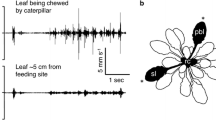Summary
-
1.
When the pupal cuticle was peeled from aroundAntheraea pernyi andHyalophora cecropia moths on the last day of adult development, the animals showed reduced levels of adult behavior. Clawing and extension movements of the legs as well as wing flapping were seen, but complex behaviors such as the righting response and walking were absent (A. pernyi) or only occasionally observed (H. cecropia).
-
2.
Injection of the eclosion hormone into “peeled” moths was followed 2 to 3 hours later by the onset of the eclosion movements. Walking behavior and the righting response appeared abruptly at the time of eclosion.
-
3.
The development of certain adult behaviors was examined by peelingA. pernyi moths that were in the 14th through 19th (last) day of adult development. Animals peeled on days 16 or 17 showed distinct eclosion movements which started within a few minutes after peeling. But on day 18, this behavior became suppressed and could no longer be elicited by peeling.
-
4.
Sensitivity to the eclosion hormone did not appear until day 18 and became fully developed on day 19.
-
5.
Injection of picrotoxin into peeled day 19A. pernyi resulted in the abrupt onset of walking behavior.
-
6.
It was concluded that certain adult behaviors such as eclosion and walking become complete and functional during adult development. But as development progresses, these then become repressed—presumably through neural inhibition. The eclosion hormone apparently acts by turning off this inhibition.
Similar content being viewed by others
References
Bentley, D.R.: Postembryonic development of insect motor systems. In: Developmental neurobiology of arthropods (ed. D. Young), pp. 147–177. Cambridge: Cambridge University Press 1973
Bentley, D.R., Hoy, R.R.: Postembryonic development of adult motor patterns in crickets: a neural analysis. Science170, 1409–1411 (1970)
Blest, A.D.: The evolution, ontogeny and quantitative control of settling movements of some new world saturniid moths, with some comments on distance communication by honey bees. Behaviour16, 188–253 (1960)
Ephrussi, B., Beadle, G.W.: A technique of transplantation forDrosophila. Amer. Nat.70, 218–225 (1936)
Kammer, A.E., Rheuben, M.B.: Adult motor patterns recorded from the muscles of moth pupae. Amer. Zool.14, 1272 (1974)
Kaufmann, L.: Untersuchungen zur Funktion der Flugmuskulatur vonAntheraea polyphemus (Lep.) während der Imaginalentwicklung. Rev. suisse Zool.78, 1007–1036 (1971)
Milburn, N.S., Roeder, K.D.: Control of efferent activity in the cockroach terminal abdominal ganglion by extracts of the corpora cardiaca. Gen. comp. Endocr.2, 70–76 (1962)
Milburn, N., Weiant, E.A., Roeder, K.D.: The release of efferent nerve activity in the roach,Periplaneta americana, by extracts of the corpus cardiacum. Biol. Bull.118, 111–119 (1960)
Pichon, Y.: The pharmacology of the insect nervous system. In: The physiology of insecta, 2nd ed., Vol. IV, (ed. M. Rockstein), pp. 101–174. New York: Academic Press 1974
Schneiderman, H.A., Williams, C.M.: The physiology of insect diapause. IX. The cytochrome oxidase system in relation to the diapause and development of the Cecropia silkworm. Biol. Bull.106, 238–252 (1954)
Taylor, H.M., Truman, J.W.: Metamorphosis of the abdominal ganglia of the tobacco hornworm,Manduca sexta: changes in populations of identified motor neurons. J. comp. Physiol.90, 367–388 (1974)
Truman, J.W.: The control of ecdysis in silkmoths. Ph.D. Thesis, Harvard University (1970)
Truman, J.W.: Physiology of insect ecdysis. I. The eclosion behaviour of saturniid moths and its hormonal release. J. exp. Biol.54, 805–814 (1971)
Truman, J.W.: How moths “turn-on”: a study of the action of hormones on the nervous system. Amer. Scientist61, 700–706 (1973)
Truman, J.W., Riddiford, L.M.: Neuroendocrine control of ecdysis in silkmoths. Science167, 1624–1626 (1970)
Truman, J.W., Sokolove, P.G.: Silkmoth eclosion: hormonal triggering of a centrally programmed pattern of behavior. Science175, 1491–1493 (1972)
Williams, C.M., Adkisson, P.L.: Physiology of insect diapause. XIV. An endocrine mechanism for the photoperiodic control of pupal diapause in the oak silkworm,Antheraea pernyi. Biol. Bull.127, 511–525 (1964)
Author information
Authors and Affiliations
Additional information
I thank Professor L.M. Riddiford for a critical reading of the manuscript. This study was supported by NSF grant BMS 75-02272.
Rights and permissions
About this article
Cite this article
Truman, J.W. Development and hormonal release of adult behavior patterns in silkmoths. J. Comp. Physiol. 107, 39–48 (1976). https://doi.org/10.1007/BF00663917
Received:
Issue Date:
DOI: https://doi.org/10.1007/BF00663917




